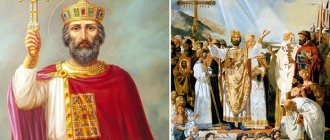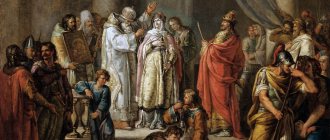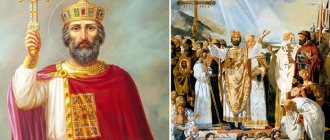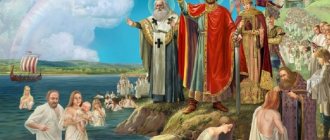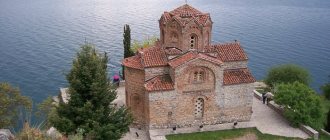Baptism in Rus' is a phrase by which modern historical science means the introduction of Christian teaching as a state religion on the territory of the fatherland. This significant event took place at the end of the 10th century under the leadership of Grand Duke Vladimir.
Historical sources give conflicting information about the exact date of the adoption of Christianity, with a difference of two to three years. Traditionally, the event dates back to 988 and is considered the beginning of the formation of the Russian Church.
Baptism of Rus' in 988
The emergence of Christianity in Rus'
Orthodoxy was declared the official religion of Kievan Rus in 988. Prince Vladimir Svyatoslavovich, together with his retinue, was the first to be baptized. The exact date is not known for certain, but it happened immediately after the fight with Varda Foka, where the Slavic troops acted on the side of the Byzantine Emperor Vasily II the Bulgarian Slayer.
The baptism of Rus' took place in 988
Reasons for the adoption of Christianity in Rus'
Until the 10th century, our ancestors professed the Vedic faith. In the divine pantheon of the Slavs, there were 14 gods, the main one of which was Rod, the creator of all things. The Grand Duke of Kiev was also a pagan, but contrary to established foundations, he installed Perun in place of the main deity and even erected several monuments, which he ordered to be worshiped. People who worship other idols found themselves disagreeing with Vladimir the Great, which led to disunity.
To reunite the divided state, the Kiev prince decided to establish a new religion. In 980, it was decided to send ambassadors to several countries with different religions. After long negotiations, the prince's choice fell on Byzantine Christianity, which amazed the ruler of Rus' with its magnificent ceremony. Another reason was the desire to maintain partnerships with Byzantium. Having married the emperor's daughter, Vladimir the Great rejected the Vedic faith, becoming the first Christian.
Consequences of accepting Christianity
The adoption of Orthodoxy played a vital role in the formation of the Russian state. The faith that replaced paganism significantly strengthened the international ties of Kievan Rus. Thanks to Christianization, the Grand Duke found powerful allies from the West and Southern lands.
Reasons and significance of accepting Christianity
The new religion was of great importance in the socialization of Slavic society. According to Orthodox tenets, the ruler was endowed with a divine nature, and the church became the right hand of power. Having influence on all aspects of human life, she quickly revived all state institutions, uniting the people with a single faith.
Soon after Christianity was born, Slavic culture began to flourish at a rapid pace. In a fairly short period of time, a new movement in architecture and painting was formed, where the Byzantine influence was clearly visible. The introduction of a new religion led to the creation of the Cyrillic alphabet. This event became the basis of ancient Russian book traditions.
Difficult choice
Photo: Elitsy.ru
It is well known that the Russian princes, when choosing which religion to adopt, considered a large number of options. The Tale of Bygone Years contains a mention that in 986 Christian priests from Constantinople came to Kyiv, but they were not the only ones who “presented” their faith.
In the capital of the principality at that moment there were missionaries from Rome, representatives of Islam and Judaism. According to legend, Vladimir really liked the speech of the preacher from Greece. But he did not rush to choose a religion, sending ambassadors to different parts of the world so that they could become more closely acquainted with each religion on the spot.
The rituals and rituals that existed among Muslims and representatives of other faiths did not make any impression on the ambassadors. But they were delighted with what they saw in Constantinople. They were amazed by the scale and decoration of the temples. Therefore, returning to Kyiv, they began to convince the prince to make a choice in favor of the Christian faith.
The decisive factors that tipped the scales in favor of the Christian religion were reasons determined by the military-political situation of the principality. Vladimir sent troops to the Byzantine city of Korsun (Chersonese) for military assistance, and in return wanted to marry a representative of the imperial house, Anna. Emperor Vasily II, who was in Korsun, violated the agreement: he used the services of the Russian army, but in return did not marry his sister Anna to the Kyiv prince.
The formation of the church in Rus'
The history of Russian Orthodoxy is quite controversial. One can judge what influence pagan culture had on its formation by the traditions that have survived to this day. Thanks to the symbiosis of two faiths, Christian and Vedic, Kievan Rus led the eastern direction of the Ecumenical Church, and also became the main engine of national thought.
Leaving idolatry turned out to be less painful than Prince Vladimir had expected. Since the Vedic faith was never able to fully fill the consciousness of our ancestors, the abolition of the old gods did not entail particularly large rebellions.
The Orthodox Church rather gently carried out the replacement of concepts, but it has not yet been possible to completely eradicate pagan superstitions.
Paganism turned out to be fertile ground for cultivating faith in Jesus Christ. From the first days, church services of Russian Orthodoxy were distinguished by incredible pomp and spirituality. The Slavs especially strongly felt closeness to the Almighty, as well as His divine presence in everything that surrounded them.
Stages of development of the Orthodox Church
However, the formation of the Orthodox Church in Rus' was not without tragedy. Thus, the sons of the Kyiv prince - Gleb and Boris, who were later elevated to holy great martyrs, became victims of the struggle between two faiths. The alien religion that was gaining momentum pushed Svyatopolk, another son of Vladimir, away from the cherished throne. Such kindred hatred forced him to get rid of competitors who did not want to respond to aggression with aggression.
Vladimir's baptism
Photo: Monsvelisavetialap.ru
We had to take Korsun by force. The city spent 9 months under siege until it finally surrendered. Vasily was forced to marry his sister to Vladimir, and the Russian prince himself was baptized in Korsun.
Returning to his homeland, Prince Vladimir begins to methodically eradicate paganism. He orders the destruction of all idols, and baptizes the people right in the Dnieper. Immediately after this, a plan was developed for the grandiose construction of churches on the territory of Kyiv and in other large and significant cities of Rus'. Priests began to be appointed to new churches.
Vladimir himself completely abandoned the pagan faith. Historians who have researched his biography claim that he witnessed a Revelation that allowed him to completely abandon his old beliefs. It was after this spiritual rebirth that the prince decided to completely destroy idols and baptize the people. He became an ardent supporter of Christianity.
The baptism of Rus' took place according to orders. Many were not happy about having to convert to a new religion, abandoning the beliefs that many generations of their ancestors had followed. In some cities of Rus', the authorities even resisted, but Vladimir was adamant. Dissenters were pushed aside, the prince acted decisively, spreading and strengthening the faith in his country.
It is noteworthy that the very first Russian ruler to be baptized was Princess Olga. According to one version, she was in Constantinople on an official visit, where she became acquainted with the features and essence of the Christian church. She decided to convert to Christianity. After baptism she received the name Elena. Until the end of her life she sought equal participation of Rus' and Byzantium in resolving any issues.
Spreading knowledge about religion
Next after Vladimir the Great, his other son, Yaroslav, ascended the Kiev throne. He began to actively educate the Slavic people in order to further strengthen the faith of Christ in people. Thanks to the lofty idea of raising Kievan Rus to the level of great powers, he gained authority not only among the Slavs, but also among leading European countries.
The young prince established relations with other Orthodox states, expanded the consciousness of his people, and did not allow them to withdraw into themselves. Receiving ambassadors from different powers, Yaroslav the Wise tried in every possible way to adopt their religious experience in order to later apply it to the model of the Russian church.
At the invitation of the new ruler, foreign clergy began to visit local monasteries, bringing with them religious literature, later translated into Old Russian. This is how the development and formation of book traditions began, from which the monuments of ancient Russian writing known to us came out. Russian clergy copied sacred manuscripts, and ordinary people were taught to read and write, opening Sunday schools for this purpose. By order of Yaroslav the Wise, the first library was organized, where religious works were freely available.
The heyday of Kievan Rus occurred under the reign of Yaroslav the Wise
Meaning: political, cultural
Already in the first decades after Epiphany, the country changed even externally. The cities were decorated with churches (in Kyiv alone there were up to several hundred churches!), writing came to Rus', created by Sts. Cyril and Methodius , and with it - all the spiritual wealth of the Christian world that existed for almost 1000 years.
Christianization made Rus' part of it, strengthening its international position. She exalted the power, as given by God, and... changed it itself.
Perhaps Vladimir was the first ruler to realize that he not only had the right to collect tribute, but also responsibilities, including caring for his subjects. The people of Kiev watched in amazement as every Sunday at the princely court they distributed alms to the poor and organized dinners for the poor. They said that Vladimir also wanted to abolish the death penalty, punishment in general. It was not according to reason that the prince, who was zealous for the commandments, had to be convinced by the priests.
However, the path to a truly Christian life was long and difficult. The strife and the struggle of ambitions have not gone away. And the feat of the sons of Vladimir, Boris and Gleb (1015), who preferred death to participation in civil strife with their brothers, for a long time, unfortunately, was the exception that confirms the rule.
Book Vladimir presents the book. Boris receives a sword and sends him to war with the Pechenegs. Burial of the prince Vladimir. Mark of the icon “Saints Boris and Gleb in the Life” from the Boris and Gleb Church. in Zaprudi in Kolomna. Con. XIV century (TG)
Religious culture in Rus'
With the development of Christianity, the structure of the church began to emerge. It represented many metropolises. It was not possible to establish exactly how many there were initially, but they were all united by a common board - the bishop of Constantinople.
Later, Yaroslav the Wise appointed the Russian Saint Hilarion as metropolitan. It was he who became the main popularizer of religious culture. From his pen came the famous treatise “Tales of Law and Grace.” With his blessing, Orthodox writers published historical works, introduced the people to the biographies of ancient princes, as well as significant events in the history of Kievan Rus. The works represented the quintessence of folklore, archival documentation and oral tales of eyewitnesses. Two centuries after baptism, Nestor the Chronicler structured all this information by writing the “Tale of Bygone Years” known to all of us.
Nestor the Chronicler is the author of The Tale of Bygone Years
After the Christianization of Rus', an educated layer of society began to appear - scientists, writers, architects, icon painters. It was with their hands that the St. Sophia Church and the Golden Gate in Kyiv were erected.
Interesting information
Today, even a schoolchild knows in what year the Baptism of Rus' took place. However, few people consider this topic from a cause-and-effect perspective. As we see, the adoption of Christianity exalted the ancient Slavic state and served as a solid basis for the formation of a modern Orthodox society.
If you find an error, please select a piece of text and press Ctrl+Enter.
Was there a visit to the ap. Andrey Rusi
The chronicler, St. Petersburg, talks about him. Nestor. According to him, St. Andrei walked the entire Russian land from the south (the future Kyiv) to the place where Novgorod would later arise. There are different opinions about the degree of historicity of this legend. Modern scientists say: St. The Apostle Andrew the First-Called actually preached in “Scythia,” as the Romans called the territory north of the Black Sea.
The fact that the saint could climb the Dnieper to the place where Kyiv was is also not impossible. Finally, his preaching could be heard by the Slavs who then lived in the lands of Eastern Europe.
Apostle Andrew the First-Called. Greek fresco, Fr. Cyprus, XI century
Baptism of Novgorod: on the threshold of civil war
Problems arose already at the first stage of the spread of Christianity - Veliky Novgorod became a center of resistance. The religious issue was closely intertwined with the political: noble people of the former capital of Rus' were wary of the will of Kyiv, seeing in baptism a possible weakening of their independence. Vladimir was also aware of the problems, so in 990 a military expedition under the leadership of Voivode Dobrynya, the uncle of the Kyiv prince, set off to the north-west of the country.
Initially, Dobrynya and clergy sent from Kyiv baptized several hundred Novgorodians who agreed to this event in order to convince the local population of the correctness of this decision. The following year, during a new campaign, the Novgorodians, led by the thousand Ugonai and the sorcerer Bogomil, decided to resist the Kievans. An uprising began, during which the pagans destroyed the house where Dobrynya was located. He decided to act quickly - it was the surprise of actions that could ensure his victory over the superior forces of the rebels.
His comrade Putyata tied up the superior forces of the Novgorodians in battle, and at this time Dobrynya himself began to burn the houses of the pagans. The fire quickly spread among the wooden houses, which forced the rebels to negotiate with the people of Kiev. At a citywide meeting, city residents allowed the construction of churches in Novgorod and promised not to interfere with Christian preachers, but a very small number of citizens wished to be baptized.
This did not suit Dobrynya - he began to carry out religious rituals by force, using his troops, and also destroyed pagan sanctuaries and temples. The people of Kiev celebrated the victory. And although many Novgorodians adopted Christianity only out of fear of the authorities - for a long time pagan gods were secretly revered in the city - nevertheless, Vladimir Svyatoslavich celebrated his victory: he managed to subjugate the second most important city of the state to his will.
Modern view of the Volkhov River, where Novgorodians were baptized. Source: wikipedia.org
The process of baptism of Russian lands dragged on for decades. In fact, only residents of large cities converted to the new faith, but their loyalty was often subject to great doubt. The border territories of the state remained pagan for a long time: for example, the Vyatichi tribe refused to convert to Christianity, according to some sources, until the 14th century.
After the baptism, the former pagan clergy and sympathizers of Perun went underground. Temples were erected throughout the country, and clerics arrived from Byzantium to train clergy from the local population. The Magi were just waiting for an opportunity to show themselves in all their glory, and such opportunities were repeatedly given to them throughout the 11th century.
Magus Fantasy of a modern artist. Source: commons.wikimedia.org
The first major uprising took place in Suzdal in 1024, when the region was struck by a terrible crop failure and drought: there was not enough food, and ordinary people tried to find the culprits of the bad weather. The Magi were near them in time: they blamed the tribal nobility for all the troubles. According to pagan traditions, the guilty were sacrificed to appease the gods. This is what the rebels did, simultaneously putting elderly people to death in order to “renew” the earth. Yaroslav the Wise did not react in any way to the speech of the residents of Suzdal - the uprising died out on its own.
The most famous pagan performances occurred 50 years after the events in Suzdal. In 1071, the people of Rostov and Novgorod rebelled, and the rebellion happened for exactly the same reasons as in Suzdal - drought, crop failure and distrust of noble people who, it seemed, were hiding food supplies. In both cases, the performances were led by Magi who emerged from underground. This suggests that the pagan faith was still deeply rooted in the people, because a little less than a hundred years passed after the baptism of Rus'.
In Novgorod, according to the Tale of Bygone Years, in 1071 a nameless sorcerer appeared on the streets of the city and began to agitate the local population against the local bishop. The chronicler reports that only Prince Gleb and his retinue remained on the side of the Christian cleric - 80 years after the city was baptized by Dobrynya, the overwhelming majority of the townspeople sympathized or at least were sympathetic to pagan cults.
Street fighting almost broke out in Novgorod, but the prince quickly stopped a possible attack by simply killing the sorcerer. It is interesting that after the death of the leader, the dissatisfied simply went home.
Andrey Ryabushkin. Prince Gleb Svyatoslavovich kills the sorcerer at the Novgorod Assembly. 1898 Source: commons.wikimedia.org
In Rostov, also against the backdrop of crop failures, in 1071 two wise men from Yaroslavl appeared and began to brand Christian clergy and the local nobility - they say that they are to blame for all the troubles that befell the common people. Having gathered a certain number of associates, the pagans began to destroy the surrounding churchyards, specifically pointing out noble women, accusing them of hiding food. Soon the rebels reached Beloozero, where Jan Vyshatich, the governor of Prince Svyatoslav Yaroslavich, was located. The rebels and Jan's detachment clashed near the city, but the battle ended in nothing.
Then the governor turned to the residents of Beloozero and demanded that they deal with the Magi on their own while his detachment collected tribute. The townspeople soon complied with the request of the princely envoy; the pagan clergy were caught, interrogated, and then handed over to the relatives of the murdered women.
Sergey Ivanov. Jan Vyshatic and the pagans. 1912 Source: commons.wikimedia.org
The Suzdal, Novgorod and Rostov events turned out to be the largest uprisings of the 11th century. However, chroniclers also reported a surge in robbery on the roads: “dashing people” became a headache for the princes at the turn of the 10th and 11th centuries. Apparently, religious changes, coupled with constant civil strife, became one of the reasons for the deterioration of the situation in the country. The Baptism of Rus' divided society for many decades.
Christianity in the 10th and 11th centuries was able to gain a foothold in the large cities of Ancient Rus', which nevertheless did not prevent local residents from periodically rebelling under the leadership of pagan priests. In rural areas and regions remote from trade routes, the situation was even more complicated. It can be reconstructed using data obtained through archaeological excavations. Artifacts discovered in the burials suggest that dual faith reigned among most of the population: Christian rituals and relics coexisted with pagan ones.
An echo of this phenomenon can be observed to this day: people celebrate Maslenitsa, celebrate carols, and jump over the fire on Midsummer Day. “Holy Rus'” was never able to completely rid itself of its pagan past.
The bloody baptism of Rus' is most likely not fiction; armed confrontations could have taken place in Novgorod
However, the forced baptism of Rus' is reflected in historical sources. This is a fact and we cannot close our eyes to it. The Baptism of Novgorod is an important event in the Christianization of Rus', and it did not pass bloodlessly.
In 991, Bishop Joachim Korsunyanin and governor Dobrynya went with the Kyiv squad to Novgorod.
However, the inhabitants of the great city did not at all want to accept the new religion. There were also political reasons for this, because to become Christians meant to depend on the Kyiv prince.
Veliky Novgorod is a city that, according to the Joachim Chronicle, was baptized with fire and sword.
Armed resistance began.
Often supporters of the version of the bloodless baptism of Rus' cite numbers as arguments. They reason like this: a maximum of 40 thousand people could be recruited into the squad. What are they against the rebellious people?
But Dobrynya did not need a numerical advantage. He simply began burning the houses of the Novgorodians until they surrendered and allowed the spread of Christianity on their territory.
However, not all researchers believe this story.
Historian Alekseev S.V. indicates that the only source of this story is the “Joachim Chronicle”. Not everyone considers this document to be authentic. There is a version that this is a late fake.
